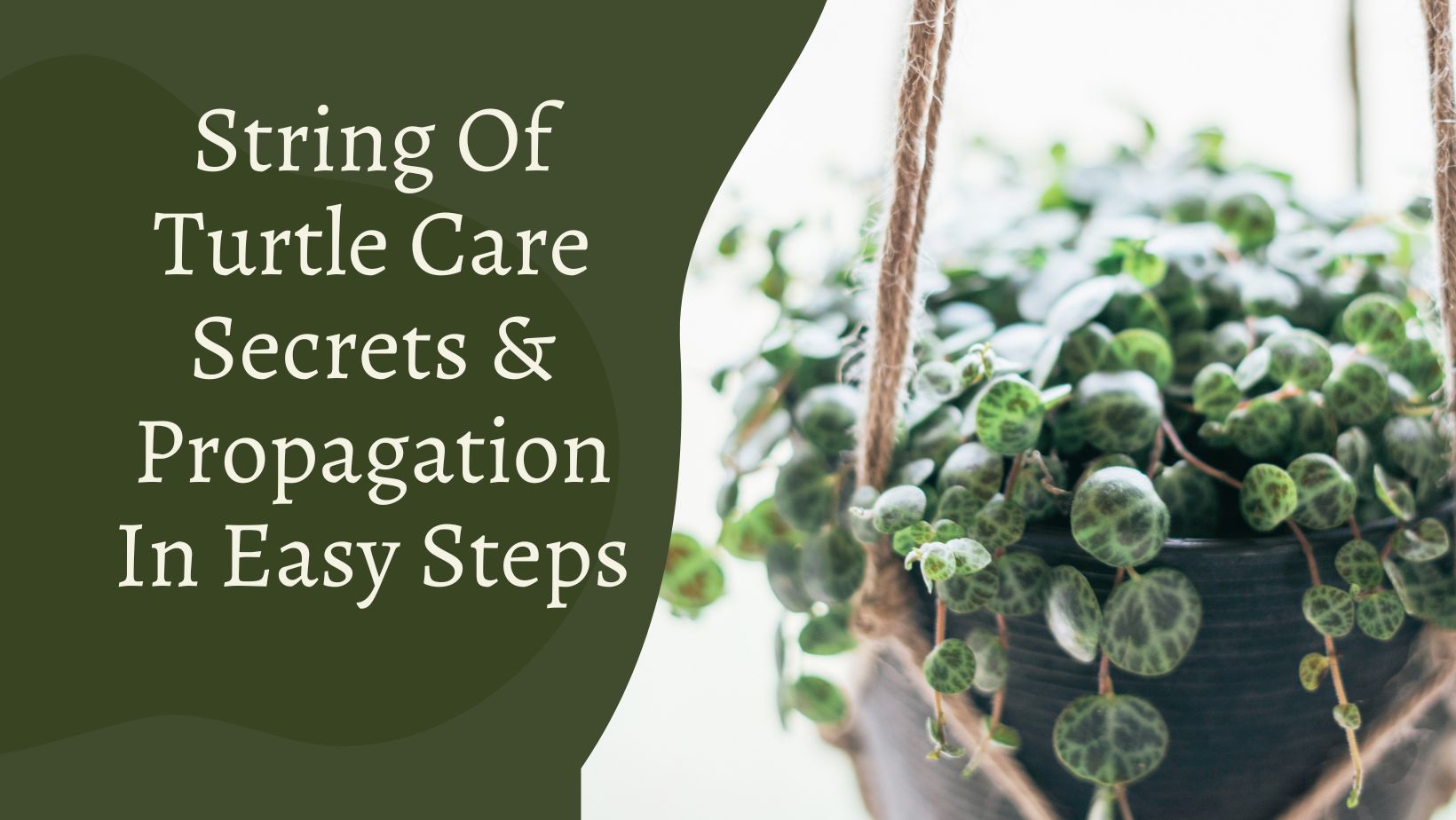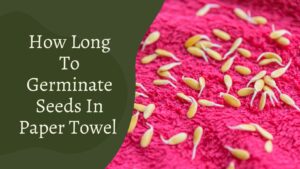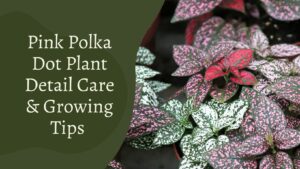
Peperomia prostrata is the scientific name for the string of turtles plant. The genus Peperomia has approximately 1,500 species, with watermelon peperomia and peperomia obtusfolia being two of the most well-known. String of turtle care is important for their constant growth.
The majority of peperomias are low-maintenance, but a string of turtles plant in particular tolerates neglect well. In fact, overwatering is the most dangerous thing you can do to this plant, so only water when necessary and make sure your turtle string is planted in well-draining soil. The turtle plant is a slow-growing plant that takes around 3-5 years to mature. The vines may grow up to 12 inches long and reach a maximum height of around 1-4 inches.
Each leaf is shaped like a turtle and has a rubbery feel with a segmented design in dark and bright green tones. The rubbery leaf surface and the patterned leaves are shown in this photo: The stems are orange to orange-red in hue and can be seen between the leaves, giving the plant a nice depth of colour.

Is a Succulent a String of Turtles?
The String of Turtles is a semi-succulent plant that is also classified as a tropical plant. It can live with little irrigation because it is a succulent plant. However, being a tropical plant, it thrives in the presence of rain and humidity!
The deep green variegated leaves of Peperomia Prostrata with light, white veining carry enough sap to keep the plant hydrated. Because it’s designed to conserve water during dry seasons, waterings should be spaced apart.
Its succulent nature also makes it resistant to low light and periods of submersion. Peperomia Prostrata, on the other hand, demands somewhat more humidity and water than other succulents.
Is the String of Turtles Plant poisonous?
The Plant of the String of Turtles is non-toxic. Some plants have an effect on the human body because they contain alkaloids in their sap, which induce discomfort when touched or eaten by accident, and can be fatal if significant. String of Turtles Plant leaves and sap, on the other hand, are devoid of poisonous chemicals and may be cultivated safely inside.
It may also absorb toxic elements in the air, allowing us to develop in a better environment. String of Turtles Plants might be purchased if your home has just been remodelled. Additionally, put it near your workplace to protect your eyes from radiation, alleviate weariness, and reduce fatigue.
Is a String of Turtles rare?
The String of Turtles was once considered uncommon, but because to its recent popularity, it is now widely available at nurseries and garden stores. There aren’t many plants that are both succulent and tropical, which is another rarity. It stands out among other vining plants because of its turtle-like leaves and patterns.
Do Turtle Strings Grow Quickly?
String of Turtles takes a long time to mature, particularly when it is young. They only need 3 to 5 years to reach a height of around 12 inches. Peperomia Prostrata’s maximum width will vary depending on pot size, but being a bushy and vining plant, anticipate it to grow wider than tall.
A rooting hormone or fertiliser can assist produce roots quicker when propagating or repotting. However, expect to wait approximately a month for any new sprouts to emerge above the earth.
When to Propagate String of Turtles
Spring to mid-summer is the optimal period to spread the String of Pearls. When the plant is in the growth season, the success rate of propagation is maximum. Choose a beautiful morning to propagate throughout the summer. In the fall, you may cultivate the String of Turtles plant inside, but not in the winter. The plant can’t resist the freezing temperatures and chilly draughts, therefore the cold weather isn’t ideal.

What Happens if a String of Turtles Is Overwatered?
Overwatering is a major problem for the string of turtles plant. Signs of overwatering in string of bananas and string of string of turtle are alomst same which include Yellow foliage, withering leaves, edoema, root rot, and eventual plant death/
Overwatering Symptoms
- Leaves of a string of turtles are yellowing or wilting.
Iron deficiency, which can be caused by overwatering, causes the yellow leaves on the string of turtles. When you overwater your plant, it washes away part of the nutrients in the soil and prevents the plant roots from breathing and supplying nutrients to the leaves.
- Root Rot
Overwatering a string of turtles causes the soil to get soggy, preventing roots from getting enough oxygen. As a result, the root is unable to breathe and will eventually decay. Meanwhile, an overabundance of moisture in the soul encourages the growth of germs and fungi, both of which induce root rot. When the root of the string of turtles plant rots, the leaves of the plant wilt, become yellow, and finally fall off. This is due to the fact that the plant would most likely be dead at this point.
Problems Associated with a String of Turtles
Although String of Turtles is not particularly susceptible to pests and illnesses, it is always a good idea to keep a watch out for concerns that may be avoided. Root rot, whiteflies, mealybugs, and spider mites, like any other houseplant, are the most likely candidates for any plant problems.
Rotten Roots
Inadequate care is nearly often the cause of root rot in String of Turtles. Overwatering and wet soil are the major culprits; these succulents like only slightly damp soil. Allowing the roots to soak in water will cause the roots to decay.
Root rot can also be caused by a lack of sunshine or cold temperatures that prevent the soil from drying up. Peperomia Prostrata will not retain too much moisture if it is exposed to bright, indirect sunshine at 65° to 75°F.
Root rot can be identified by drooping stems, yellow or brown foliage, and falling leaves. Allow the soil to dry for two weeks before watering gently(!) again. Root rot will limit the plant’s growth and the vines will die if it is not addressed.
Leaves that have been damaged
Overwatering is indicated by wilted, scab-like bumps on the String of Turtles’ leaves. The nutrients are washed away and the leaves shed when the roots become too damp. Peperomia Prostrata might get bland and faded if it is exposed to direct sunlight. Relocate the plant away from direct sunshine if the leaves are losing their colourful diversity.
Another indicator of overexposure to bright sunlight is red foliage. To address the issue, limit sun exposure to one hour every day. To assist your String of Turtles in producing new growth, remove any damaged red or yellow leaves.

Mites seen on spiders
Spider mites spin little webs on the undersides of leaves and in the leaf joints. These spiders, which are white, crimson, or black in appearance, make the plant leaves appear dusty and drab. Because most interior conditions are dry throughout the winter, they constitute an issue. Spider mites reproduce quickly and feed on the sap of the String of Turtles’ leaves, discolouring and drying the vines. Peperomia Prostrata will finally be killed by spider mites. To prevent Spider Mite infections, keep the humidity levels high, apply neem oil as a preventative spray, and wash the plant with insecticidal detergent.
Whiteflies
Whiteflies are small white flying insects that are typical houseplant pests. They suck the liquids from the leaves and flower buds, causing the leaves to yellow and fall off. If the plant is affected, the adult flies will emerge when the leaves are disturbed. They deposit their eggs on the undersides of the leaves, so look for eggs or whiteflies.
Whiteflies may readily kill tiny indoor plants like the Peperomia Prostrata, despite the fact that infection is uncommon. Insecticidal soap can be used to destroy pest eggs, and neem oil can be sprayed to keep them away.
A string of turtles plant may be the pride of a tropical plant collection when String of turtle care properly, but it will require some work and adaptation from the standard procedures used to maintain most succulents. However, unique does not imply difficult. A well-kept Peperomia prostrata will reward its owners with a one-of-a-kind, vining succulent.
Light for string of turtle care
Plants that grow in a string of turtles like and thrive in intense indirect sunlight. The leaves of these plants will be destroyed if they are exposed to direct sunlight for a lengthy period of time, but they will not establish new growth if they are exposed to little light.
Because of the plant’s vining nature, ensure that light reaches the top so that new growth may proceed. Vining plants are commonly placed on high shelves or in dim light, forcing them to cease growing. Ascertain that light reaches all areas of the plant.
Soil
Succulent gardeners are likely to be used to using pre-mixed soil specifically suited for succulents and cacti. These premixes should not be used for string turtle plants.
Instead, a combination based mostly on organic materials should be used. It’s ideal if it has a lot of peat. This formula will be included in a commercial seed starting mix.
Peat is acidic, which is perfect for this plant, but don’t allow the pH go too low. Testing the soil on a regular basis is a good idea. Examine the soil to determine if it drains properly.
Water string of turtle care
Turtles’ water string plants are more vulnerable to overwatering than they are to dry conditions. Because it is native to the Brazilian rainforest, the plant requires some moisture. Check the container for drainage holes, water well, and then let the soil dry between waterings.
To avoid overwatering, soak the soil until water drips out the bottom of the pot and the earth is completely saturated. Before watering the plant again, wait until the top two inches of soil have dried up.
Temperature and Humidity
Rather with the higher temperatures that most succulent fans are used to, this plant prefers softer, more humid conditions. Keep your string of turtles plant at a constant temperature of 68 to 75 degrees Fahrenheit.
Keep it away from exterior doors and draughty windows, and if you set it outside in the summer, bring it inside before the weather turns chilly.
During the dry summer months or while a heater is running in the winter, you may want to use a mister or humidifier to boost humidity around the plant, as long as the leaves are not moist.
Fertilizer
Feeding a string of turtles will help the plant retain its lustrous vitality and keep the colour and patterns of the leaves consistent throughout the growth season. During the growth season, feed it biweekly with a diluted houseplant fertiliser; fertilisation is not suggested in the fall or winter.
String of Turtles Pruning
String of turtles plants that are not trimmed on a regular basis can become untidy, ragged, and lanky. Pruning on a regular basis will allow you to eliminate dead and damaged stems and leaves, as well as calm unruly growth like trimming your topped plants. It also fosters the emergence of new, more aggressive growth. All pruning should be done using disinfected scissors or razor-sharp snips.
String of Turtles Propagation Methods & Steps
The simplest and quickest technique of propagating string turtles is through stem cutting. It is the ideal technique to work with if you are new to propagation. It may be propagated from stem cuttings in both soil and water. Growing the String of Turtles from seed can be a time-consuming task with a poor germination rate.
Grow a Turtle String from Stem Cuttings in Soil
Observing the node and preparing proper soil for the plant are the most important considerations when utilising soil to propagate a String of Turtles plant. String of Turtles may be propagated in soil via stem cuttings.
Step 1:
Snip a few cuttings from healthy areas immediately below a node (where leaves and roots grow out of the main stem). Always use a clean pair of scissors or knife. Remove some of the leaves that are near to the cutting’s base, leaving only 2 or 3 leaves.
Step 2:
Place the cutting’s base in a container filled with soil mix. Don’t bury the entire cutting, but make sure there is at least one node in the soil from which new roots will develop. (If you like, you may also sprinkle some rooting hormone powder on the nodes.)
Step 3:
Place the pot in a bright, indirect light source. Maintain a wet top layer of potting mix, but do not overwater. You don’t need to water the soil again if it was previously moist.
Step 4:
Use saran wrap to cover the top of the planter and poke holes in it for air circulation. Remove the saran wrap every week or so to allow the plant to breathe. If the soil is dry, mist it with fresh water.
In water, propagate a string of turtles using stem cuttings.
The propagation of string turtles can be done in water. Though it will take longer to take root in water than in soil, this method is considerably more enjoyable since you can see the roots develop in real time. The following are the steps:
Step 1:
Get a clear, clean container ready.
Step 2:
Cut a few healthy cuttings below a node and remove all the leaves near to the cutting’s base.
Step 3:
Place the cutting’s base into the container. Then, approximately a third of the way up the root system, fill the container with water. String of Turtles’ root system will not breathe properly if there is too much water. You may place some medicinal stone at the bottom of the container to help with root system repair.
Step 4:
Set the container in a bright, indirect light source.
Step 5:
When the water turns dirty, replace it once a week or so, and fill it up when the water level drops.
Sow a string of turtles from soil leaves.
String of Turtles may also be propagated from leaves in potting soil. However, the survival rate is substantially lower, and rooting might take many months.
Step 1:
Choose a few healthy leaves with connected petiples.
Step 2:
Place the leaf petiole in a moist soil mix-filled container.
Step 3:
Place the pot in a bright, indirect light source. Maintain a wet top layer of potting mix, but do not overwater. You don’t need to water the soil again right away if it was previously damp.
Step 4:
Use saran wrap to cover the top of the planter and poke holes in it for air circulation. Remove the saran wrap every week or so to allow the plant to breathe. If the soil is dry, mist it with fresh water.
Seeds in the soil can be used to propagate a string of turtles.
String of Turtles plants may be be propagated from seeds. Growing the String of Turtles from seed is a simple but time-consuming operation, with a poor germination rate. It takes a long time for the seedlings to mature.
Step 1:
Make or purchase a nice batch of String of Turtles seeds. Fill the pot halfway with sterile, wet potting soil.
Step 2:
Separately sow the seeds. Spread the dried seeds uniformly throughout the earth’s surface and cover with a tiny amount of dirt to ensure that they are completely covered.
Step 3:
Place the pot in a bright, indirect light source. Maintain a wet top layer of potting mix, but do not overwater.
Wait for the seeds to sprout. Watering should be avoided until new growth appears. In most cases, seedlings will appear in 1-2 months.

After Propagation, String of turtle care
When caring for a string of turtles plant, make sure the soil is appropriate, which should be a well-draining soil/mix. To ensure the growth of String of Turtles Plant, sufficient light should be provided and appropriate fertiliser water should be supplied to them on a regular basis. The ideal temperature for String of Turtles Plant development is approximately 25°C. The importance of watering cannot be overstated. Overwatering is a big no-no for the String of Turtles plant.
Repotting your String of Pearls: A Step-by-Step Guide
You should always position your plant in a well lit location. Though little amounts of sunshine are beneficial, too much might cause burning of the plant’s leaves.
Avoid planting this plant near windows and keep it at least a few feet away from them. Light is necessary for the plant’s life.
Repotting is a vital step in ensuring the string of pearls’ life. Many people, however, are unsure how to begin with this strategy. Should you repot the cuttings and let the mother alone, or should you remove the cuttings and repot them?
To repot the plant, follow these steps:
- Cut the four wires used to suspend the plant with wire snips.
- Place a newspaper on the table and invert the pot onto it.
- Cut these wires with the wire snips so that the pearl string pieces remain intact.
- Even if you lose some plants, you will still have a big number of them. Alternatively, a donkey’s tail can be used in this operation. When the strands are still short, it’s preferable to repot the plant.
- You’d have to remove the plant from the pot and handle it carefully. You’ll also need to remove the plant’s tangled strands if you wish to reuse the container in the future.
When to Water a Turtle String
In an ideal world, there would be just one easy guideline for watering your turtle string. Actually, there are a few other elements that decide when your plant needs to be watered and when it doesn’t, and we’ll go over those immediately.
Soil should be touched
There are a variety of methods for determining when to water the turtle string plant. Touching the dirt with your fingers is the easiest method. You can tell if the soil is still moist by pressing your finger into it to the depth of your second knuckle (approximately two inches). Even if the soil on the top seems to be dry, moisture might be present farther down the pot. If there aren’t any, it’s time to water the turtles’ pant string.
Soil Color
Because moist soil is darker in colour than dry soil, you can tell whether the soil is wet just by looking at it. The difficulty is that it just tells you what’s going on on the surface of the soil, not what’s going on beneath it.
Leaves that are wilting or drooping
Do a feel test as soon as the leaves begin to wilt or droop. If the soil is damp, you’ve overwatered the string of turtles plant, and you’ll need to let it dry out before watering it again.
Brown Leaf Tips or Wrinkled Leaves
The plants are most likely underwatered when the string of turtles leaves begin to turn brown at the tips and at the edges, or get wrinkled. It’s time to give the plant ample water.
The Pot’s Weight
As the water evaporates and the earth dries, the entire potted string of turtles will become considerably lighter. Furthermore, you must know how much the pot weighs when it is damp before comparing the weights.
Leaves Turn from Brown to Yellow
When the leaves of a string of turtles plant are overwatered, they begin to turn brown and eventually yellow. This is in contrast to the brown marks on the tips and edges mentioned before. In this case, you must act quickly to resuscitate the plant.
Conclusion:
String of turtle careThe String of turtle care is easy and it is a wonderful indoor plant to take care of. It’s easy to propagate, so you may gift cuttings to relatives and friends to add to their gardens! The Brazilian native Peperomia prostrata is a popular hanging houseplant.
It has a strong, prostrate stem with thin pointed green leaves that trail down from a central point. These plants are minimal string of turtle care because of their moderate growth pace, so you won’t have to do anything with them. It’s really simple to string of turtle care; all you have to do is make sure they get enough light and water, as well as correct trimming.Hope you get all about string of turtle care.

Hi This is Maria, We are a team of gardening enthusiasts with a passion for gardening. We have tried to bring you tips and advice enabling you to grow and maintain a healthy and beautiful garden. We Hope You Find it Useful.






